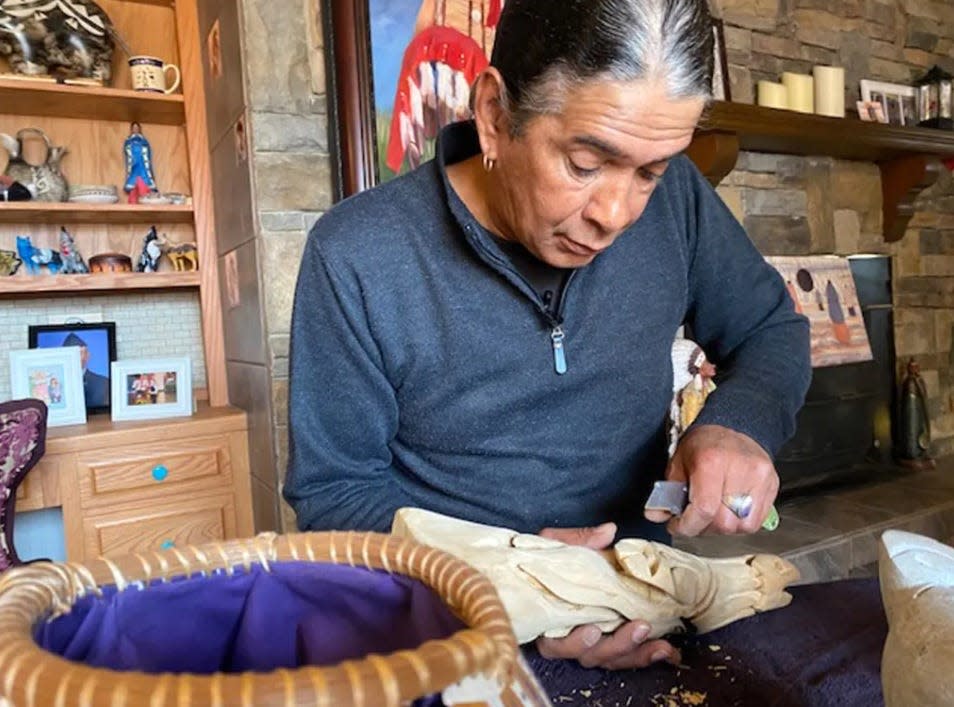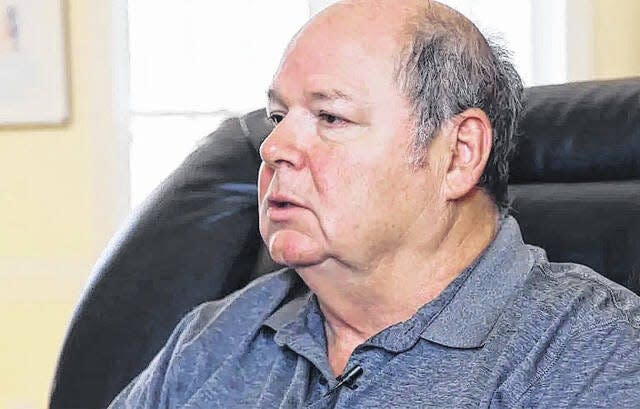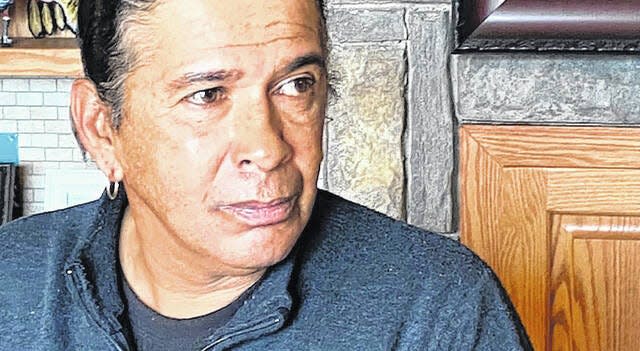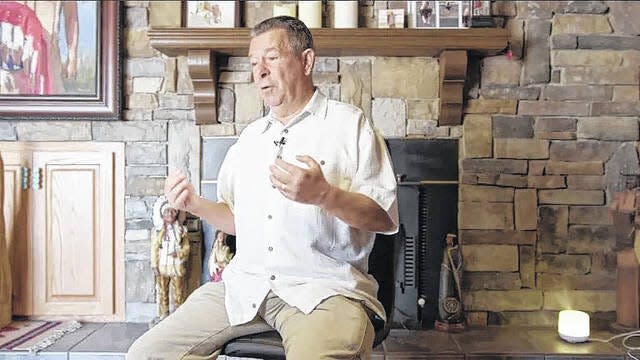He occupied a NC newspaper 35 years ago to protest corruption. He has more to say.

This story is a collaboration between the Border Belt Independent and The Assembly.
Eddie Hatcher insisted he had proof of corruption in the sheriff’s office he wanted to bring to light. Timothy Jacobs had passion and a willingness to die.
Together, Hatcher, then 30, and Jacobs, 19, crafted a plan to bring national attention to corruption and racism in Robeson County, a well-known hub of both drugs and violence in southeastern North Carolina.
More:In Robeson, one of America’s most diverse counties, the wounds of racism run deep
Rumors were swirling about the involvement of the sheriff’s office in the county’s bustling cocaine and marijuana trades. Suspicions intensified after Sheriff Hubert Stone’s son, a deputy, shot and killed a Native American man during a drug arrest.
At 10 a.m. on Feb. 1, 1988, Jacobs and Hatcher, members of the Tuscarora tribe, casually walked into The Robesonian newspaper office armed with two sawed-off shotguns they bought that morning at a local hardware store.
“We’re here,” Jacobs told the receptionist, “to occupy this building.”
More:Gas prices, inflation forcing hard choices for southeastern NC families
Confusion quickly turned to panic as Hatcher chained the door behind him. The pair rounded up 17 hostages and started making their demands to Gov. Jim Martin.
They wanted an outside investigation into the county court system and the sheriff’s treatment of Native and Black residents. They wanted the release of a local man they believed had a map showing the location of drug dealers and their connections to deputies.
More:Quilting a new Native tradition: The story of the distinctive Lumbee tribal regalia
The occupation took a page from the American Indian Movement, which for seven days in November 1972 had occupied the Interior Department headquarters in Washington, D.C., in a bid to highlight poverty, discrimination, and police brutality.
Jacobs and Hatcher set their sights on The Robesonian, a daily newspaper in Lumberton, partly because its mirrored windows facing West Fifth Street allowed people to see out but not in. They figured it was an ideal setup to hold hostages.
Plus, Jacobs recalled in a recent interview, “What other way to capture the attention of the world than to take over the media?”
During the 10 hours they occupied the paper, they talked to journalists near and far. CBS Evening News featured it that night, and it appeared in major papers like The New York Times.
In that regard, they achieved their goal. The whole world turned its focus to Robeson County. Often described as a “tri-racial” community—nearly 40 percent of residents are Native American, 25 percent are white and 22 percent are Black—racial tensions flow like the Lumber River.
What people think about that day depends on who you ask. Then and now, Robeson ranks among the poorest and most violent counties in the state. Did it shed a light on corruption and racism? Undoubtedly. Was it an unnecessary display of force? Probably that too.
The occupation is etched into the complicated history of Robeson County, now home to about 117,000 people, part of a series of events in the late 1980s and early ‘90s — including the murders of a Native American judicial candidate and of Michael Jordan’s father — that cemented the county’s reputation as one of the toughest places in the state.
Hatcher, considered the ringleader, died in prison in 2009 after he was convicted of first-degree murder in an unrelated case. Jacobs was always cast as a bit naive, an impressionable teenager along for the ride.
Now 54, he still lives in Robeson County, where he shares a home with his girlfriend of more than 30 years and services HVAC systems. In a series of interviews around the 35th anniversary of that day, it was clear that he was never just an accomplice. That fire still burns inside him. You can see it in his dark eyes when he talks about his efforts to recognize the Tuscarora — the “original” people of Eastern North Carolina, he says.

Robeson County is known as the home of the Lumbee, the largest Native American tribe east of the Mississippi River with about 55,000 members. North Carolina has recognized the Lumbee since 1885, and partial federal recognition since 1956 has allowed access to money for housing.
Jacobs wants the estimated 8,500 Tuscarora in the state to be recognized, too.
And he’s still unafraid of breaking laws to get it. In 2018, he was among more than two dozen people the state’s Alcohol Law Enforcement arrested on charges of operating illegal gaming centers. He said the Tuscarora had opened the businesses, sort of mini-casinos, as a way to raise money to hire lawyers who would fight for the tribe in Washington.
He sees it this way: “If your history is not being told, you’re not out there raising enough hell.”
The surrender
Jacobs and Hatcher raised enough hell that day in 1988 to spook Donnie Douglas.
Douglas, then the paper’s sports editor, was trying his hand on the news desk for the first time. He was in a back room when a fellow employee rushed in and said two men with guns had entered the building. Douglas dashed out the back door.
Jacobs may say that they were never going to hurt anybody, Douglas said in a recent interview, “and I’m willing to accept that. But the problem is when you have guns and you tell people there are bombs strapped to the door and you have trigger-happy police officers out there, it’s a potentially explosive situation.”

Jacobs and Hatcher knew each other through activism around Robeson County. They had both rallied for justice for Jimmy Cummings, the man Stone’s son shot dead during an attempted drug arrest, and Billy McKellar, a Black man who died of asthma complications in the county jail.
At The Robesonian, Jacobs says he and Hatcher had agreed not to harm the hostages. He also says they expected to be killed by law enforcement. Hatcher’s voice sounded increasingly urgent in a phone call with WRAL’s Charlie Gaddy.
“It’s a tense situation and it’s getting more tense by the hour,” Hatcher told the journalist. “That dark’s coming, and I’m afraid they’re going to make an unwise move.”
“What will you do?” Gaddy asked.
“What will I do?” Hatcher replied. “If they push it, somebody’s going to get hurt.”

There were 17 people inside the paper’s office; Over the course of several hours, they released 10, including those with medical conditions. Jacobs and Hatcher negotiated with law enforcement for pizza and smokes, which they shared with the hostages.
Jacobs recalled a couple of reporters pulling vodka and whiskey out of desk drawers. “They even asked me if I wanted a mixed drink, and I told them I don’t drink.”
One photo that editor Bob Horne snapped shows Hatcher, with his mullet and thick mustache, talking on the phone. Another shows Jacobs sitting casually on a desk chair, a cigarette in one hand and a sawed-off shotgun in the other.

They never got to talk to Martin, the state’s Republican governor — but his chief of staff signed an agreement to create a task force to investigate law enforcement. With a deal in place, Hatcher and Jacobs released the remaining hostages at around 8 p.m. and surrendered to the FBI, walking backwards, with their hands up, out of the newspaper building as cameras rolled.
The task force launched its inquiry on Feb. 8. Ten days later, it was over. No one was arrested as part of the investigation. Jacobs says the whole thing was a sham.
“I don’t want to call it a joke,” said Johnson Britt, who was elected as the Robeson County District Attorney in 1994. “I just don’t think it was very thorough.”
Douglas,who went on to serve as The Robesonian’s top editor and still writes for the paper, said Hatcher and Jacobs failed to show strong evidence of corruption. “If you’re going to go into a newspaper with shotguns and hold people hostage for 10 hours, that needs to be only if you can produce some goods,” he said. “And they didn’t do that.”
It took nearly two decades for real change in the Robeson County sheriff’s department, when state and federal investigators arrested more than 20 employees as part of a multi-year operation known as “Tarnished Badge.” Prosecutors said deputies took part in drug trafficking and stole money and drugs during traffic stops on Interstate 95. A few deputies accused in a money-making satellite TV scheme had worked for the office in the ‘80s, Britt said.
Sheriff Stone, who was not arrested in the operation, died in 2008. His successor, Glenn Maynor, was convicted on charges of lying to a grand jury during an investigation into alleged corruption. He resigned in 2005 and was sentenced to six years in prison.
Britt says Tarnished Badge would have happened with or without the newspaper takeover. By the early 2000s, he said, witnesses were more willing to speak up, to point fingers at deputies who had robbed them.
Jacobs still believes he and Hatcher got a victory in 1988, and that their occupation paved the way for Native Americans and Black residents to gain political power and influence in the county.

Britt agrees. “It improved race relations,” he said. “It improved representation by minorities in elected positions, in employment within county government.”
Now, three of the eight members of the Robeson County Board of Commissioners are Native American. Tiffany Powers, a superior court judge in the county, is Black. Matt Scott, a Lumbee, is the county’s first Native American district attorney.
State legislators created a second superior court judgeship in Robeson County months after the newspaper takeover; the change also followed the March 1988 murder of Julian Pierce, a Lumbee judicial candidate. The sheriff’s office said his death was a domestic matter, a theory that didn’t sit well with many in the county. A Lumbee lawyer, Dexter Brooks, was appointed to the new seat.
Scott sees Pierce and Brooks as trailblazers.
And as for the newspaper takeover?
“As we all know, peaceful protests have played a significant part in social change, in the nation and the county. But as far as taking the law in your own hands, I’m not in favor of that.”
‘In my blood’
Jacobs’ hair is longer now. He wears it pulled back, and it falls below his waist. He remains committed to honoring Native American tradition and culture.
He refuses to get a driver’s license, he says, because he doesn’t consider himself a resident of North Carolina. He uses a Tuscarora identification card when he travels to Canada.
He learned about his Tuscarora heritage from his great-grandmother and his uncle, with whom he traveled to powwows up and down the East Coast. As a teen, Jacobs spent time at the Red School House, a Native American school in St. Paul, Minnesota, where he met Native American leaders from across the United States and Canada who had been involved in the American Indian Movement.
“It’s in my blood to be what I am and who I am,” he says.
But after The Robesonian takeover, Jacobs was a young man in serious trouble.
Hatcher and Jacobs became the first people charged under the 1984 Act to Combat International Terrorism, a federal law President Ronald Reagan signed to “provide resources and authorities essential in countering the insidious threat terrorism poses to those who cherish freedom and democracy.”
Nine months after the takeover, a federal jury found Hatcher and Jacobs not guilty on kidnapping and gun charges. The news angered some Robesonian employees.
“I don’t care what your intentions are,” Douglas said. “If you walk into a building and huddle people up and you’re brandishing shotguns, you’re terrorizing those people. … How in the hell can a jury come to the conclusion that that didn’t happen?”
They were indicted two months later in Robeson County on 14 state counts of kidnapping. Both fled—Hatcher to California and Jacobs to the Onondaga Reservation in upstate New York.
Hatcher tried to seek asylum with the Soviet consulate, but was denied. He was arrested in March 1989, pleaded guilty, and was sentenced to 18 years in prison. He was released on parole in 1995, telling The Associated Press at the time that he had been diagnosed with AIDS. Six years later, he was convicted in a drive-by shooting that left a 19-year-old dead and was sentenced to life in prison. Hatcher blamed the man for a break-in at his home.
Jacobs was arrested during a traffic stop in New York and eventually surrendered. He also pleaded guilty and was sentenced to six years in prison. He served only 20 months because, he said, he participated in a program that allowed him to work at a Pizza Hut in Charlotte. He said he spent much of his time behind bars reading books about Malcolm X and other activists.
“Putting me in prison, it did nothing to change my mind, change my spirit,” he says now. “Throughout history, Geronimo was in prison, many spiritual leaders and tribal leaders have been in prison.”
When he returned to Robeson County, he struggled to find a job. People were scared to hire him, he said. He lived in a van for almost a year.
“I wouldn’t let people know I was living in that van, because I was too damn proud to admit it,” Jacobs said. “I had been in the world media, I had been on the world stage. I didn’t want people to think I was something that had sunk below.”
His passion for advocacy has not waned. The Tuscarora once dominated eastern North Carolina, but following the Tuscarora War in the early 1700s, most tribal members moved to Niagara County, New York. The descendants of the roughly 650 Tuscarora families who remained in North Carolina deserve to have land returned to them, he said. They deserve the money for health care, education, and other services that would come with full federal recognition.
But that designation seems unlikely. The Lumbees have been pushing for full recognition for decades, winning bipartisan support in Washington but pushback from other Native American tribes, including the Eastern Band of Cherokee Indians.
“We just want to be acknowledged for who we are and to be allowed to live under the original laws and agreements that we made concerning our rights,” Jacobs said.

Jacobs and Robert Chavis, a spokesman for Tuscaroras in North Carolina, are now trying to protect a swath of land in Johnston County from developers. The area, they say, is home to artifacts, burial mounds, and trees that bear the markings of their ancestors.
Both say they want indigenous people to speak up louder for themselves. They point to the Black Lives Matter Movement, which they say has been successful in bringing more awareness about racism.
“I tell our people, ‘We need to protest,’” Chavis said. “I’m not saying burn city blocks down. We need to protest more peacefully.”
On a recent Saturday, Jacobs sat in the living room of Chavis’ home in the town of Red Springs. He carved a piece of wood, his latest artwork that also includes wampum jewelry and quahog shells. He’s won awards for his art, which he says helps him connect to his heritage.
He talks about injustices around the world. He carries them, like the headdresses he wears for special events, the weight an extension of his body: the Uyghurs in China. Palestinians losing their homes. The Ukrainians dying at the hands of Russia. Children starving in Africa.
He also talks about his health — he has congestive heart failure. Jacobs does not have children, but he says his legacy will live on through his tribe, and in the stories documenting what happened 35 years ago.
“I won’t be forgotten,” he says.
This story was originally published by the Border Belt Independent, a nonprofit that publishes journalism serving the greater good of Bladen, Columbus, Robeson and Scotland counties.
This article originally appeared on The Fayetteville Observer: He occupied a NC newspaper 35 years ago to protest. He has more to say.

